Dread 2013 at De Hallen Haarlem
The Dread exhibition investigated fear in the age of technological acceleration. It is curated by Juha van 't Zelfde and will open at De Hallen Haarlem on 6 September 2013.
This was the official website for the exhibition.
Content is from the site's archived pages.
Dread warns us of danger
Dread (literally: being anxious for) is the ominous feeling in our body that warns us for possible dangers. According to the Danish philosopher Søren Kierkegaard dread is not so much a fear of the here and now, but a fear of the future. Sigmund Freud suggests that dread makes us ready for danger.
And we certainly all have experienced it. Sometimes it is warranted because their is the anticipation of danger, other times we experience because we know we are going to be caught for doing something that we shouldn't have done like playing choice online slots usa - basically gambling and losing A LOT of money when we promised the wife we wouldn't. Oops. But then there are the times when the opposite of dread- confidence- is filling you up. You just know you're going to hit the jack pot whether it's at online slots or poker. You can feel it, breathe it, and that confidence, or over confidence can then lead back to dread. Because it's so easy to find these USA online slots sites. So the best bet is IF you need to play poker or slots at an online casino site, just don't play for money. Sure winning is sweeter when there is money involved, but it sure is a bummer when you lose. So escape from the dread of having to admit you lost and just have some fun. Fortunately, although this exhibition is about dread, it's not about your dread, at least not about online gambling! Enjoy.
Artists
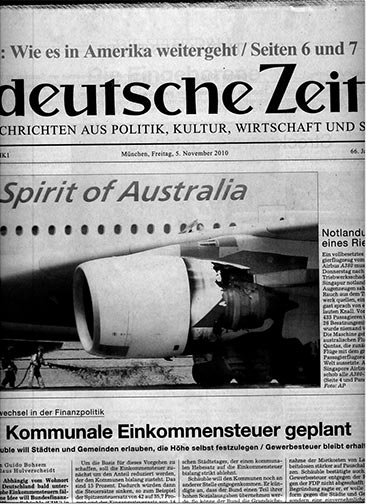
— James Beckett (Harare, 1977), Papertype: Spirit of Australia (2013) (detail)
Papertype is a loose and ongoing collection of and around the medium of paper. It includes a sheet of stamps featuring a cigarette butt, a German book by the title “Brot” on the production of bread for two million people, and an a4 sample sheet taken from a large font typewriter (the Lausanne typewriter museum) which on the rear bears a print from a desktop- printer set-up procedure. In addition there are less likely components of the group, such as the drawing tools (rulers, compasses, pencils and lead) of a former nuclear-turbine designer, as well as a collection of contaminated consumer products, purchased after their listing for recall in various newspapers.
The collection has an affinity with the technical side of life, with all components carrying a sense of the imminent: failure of the economy, technical mishap, a description of a procedure and hoarding-like ownership are criteria for this assemblage, through the common axis of paper.
Papertype: Spirit of Australia documents a set of seven newspapers, all printed on the same day and featuring variations on the same event: the burning out of an airbus a380’s engine. each print varies in quality and image treatment (scaling, crop, contrast, brightness) and in the selection of images regarding the chronological order of events. the result is a series of mediations with slight discrepancies.
James Beckett lives and works in Amsterdam. In 2003 he won the Prix de Rome.
— Kevin Slavin, Garbage Out (from: Dread—The dizziness of freedom
“Where humans are susceptible to emotional triggers and impulses, algo trading looks for — and creates — patterns that no human could ever see. Physicist are pulled off supercollider and electron microscopes to find and build the computational real-time physics of the market. These physics lie beyond the threshold of human perception. But with enough processing power, they yield.”
—
— Impressions from Frieze New York 2012 | The House Next Door
The Map of Headlessness by Thomas Hirschhorn and Marcus Steinweg will be part of Dread.
“Further peregrination through the tent maze led me to the interactive Watchword of Brazilian artist Rivane Neueunschwander at Galeria Fortes Vilaça, where I pinned up a word to the artist’s board partially filled by previous visitors; to Wolfgang Tillmans’s stunningly formal inkjet print Nachtstilleben at Galerie Chantal Crousel, and to the thought-provoking Thomas Hirschhorn, whose work The Map of Headlessness, made of the artist’s favored humble materials (cardboard, tape, paper), was placed outside one of the food courts. The Hirschhorn word-and-photomontage incorporated a wide and disparate range of images: from a black-and-white snapshot of painter Francis Bacon in his studio, or press clippings of hooded war-on-terror prisoners in orange jumpsuits, to a design-mag glossy spread of Mondrian-pattern decorative pillows. From top to bottom, one could trace the mental map, from headings like “Assertion of Truth" and “The Friendship Between Art & Philosophy," through “Ontological Abyss," “Opening Toward Contingency," and “The Void," showing an uneasy tension between art and life, order and chaos, sublimation and anxiety, merging into a kind of pictorial madness, which in turn poignantly underscores how our most enduring cultural and socio-political nightmares refuse to be contained, or mastered, by any neatly delineated system of ideas.”
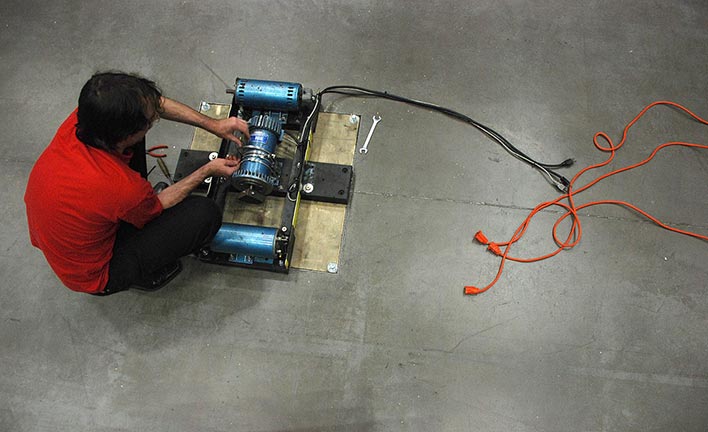
Mark Bain (Seattle, 1966), Dread Chord (2013)
In this new work for Dread renowned acoustics artist Mark Bain will explore the cultural and psychological meaning of sonic threat. Inspired by the musical history of the religious phenomenon of diabolus in musica ("the devil in music") and its more contemporary appropriation in metal and noise music, Bain introduces a forbidden chord as ominous and subliminal soundtrack of the museum
Surfing the Apocalypse, Antti Yli-Tepsa, 2012.
Surfing the Apocalypse, located on the grassy yard in front of Kiasma, is a skate ramp and a performing stage.
The ramp combines traditional skating architecture with installation art that reminds of the ominous visages and promising possibilities of the future. Its shape can be seen as an oncoming tidal wave or a snapshot of a surfer’s dream. The ramp also has a sound system, to which anyone can plug in their own players.
Surfing the Apocalypse was part of the Camouflage exhibition, and the work has been supported by Svenska Kulturfonden, Kiasma, URB and Koskinen Oy.
— Metahaven (2008, NL), Dread (2013).
Metahaven, on their commissioned ‘band logo’, presented in the Cabinet, and on T-shirts printed in limited edition: “Dread, as a techno-dystopian zeitgeist, rests intangible and un-rendered inside the fibre-optic cables, below the grey surface of the drones, and behind the ominous speech acts of cyber war-waging strategists. Styled as a word-image, ‘Dread’ becomes the ultimate totalitarian-seductive band logo of our technological age, as in ‘Doom Metal meets Cisco Systems.’ On Tour Now!”
Metahaven is an Amsterdam-based research and design collective on the cutting blade between politics and aesthetics. Metahaven’s work - both commissioned and self-directed - reflects political and social issues in provocative graphic design objects. Metahaven’s work has been published and shown worldwide. Their anthology Uncorporate Identity, was published by Lars Müller Publishers in 2010. Can Jokes Bring Down Governments was released by Strelka Press, Moscow in 2013. Black Transparency, an exhibition and pocket book, will be released in fall of 2013. Metahaven is responsible for designing the book that accompanies Dread and is published by Valiz.
— Aditya Mandayam (Bangalore, 1983), Good Good Bad Blood (2013).
Good Good Bad Blood is a new work, which Aditya Mandayam specially made for Dread. It is a mask that has been mystically fabricated from Persian shagreen, which has been bathed in the artist’s urine and stock from camels’ bones and subsequently massaged with mayonnaise, prepared from goose egg and attar of roses.
Shagreen is a sought-after sort of leather, made of the skins of sharks or rays. Its rough texture feels unusual and coarse. The French word ‘chagrin’ (anxiety) derives from ‘shagreen’.
A mask is a form of withdrawal, anonymity and invisibility and politically topical now that members of the Anonymous hacktivist group can be distinguished in public by the wearing of stylised Guy Fawkes masks.
Mandayam is also inspired by the Japanese phenomenon of kawai, the well-known form of Japanese cuteness (Hello Kitty), a longing for harmony and possibly staving off fear. The mask is reminiscent of the ‘ugly T-shirt’ in science fiction author William Gibson’s book Zero History. The wearer of this ugly T-shirt stays invisible for security cameras, because these cannot form a clear image of what they see. The wearer stays anonymous for video surveillance’s all-seeing gaze.
Aditya Mandayam is artist in residence at the Rijksakademie van beeldende kunsten. He once collaborated on Google’s driverless car project. He lives and works in Amsterdam.
About
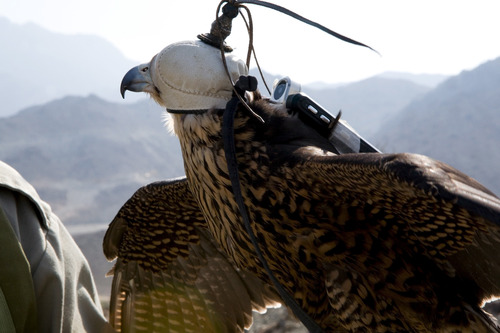
Laurent Grasso, On Air, 2009
Dread - fear in the age of technological acceleration - De Hallen Haarlem’s Young Curators’ Grant
07.09.2013 - 24.11.2013
De Hallen Haarlem opens the new season with the international group exhibition Dread – fear in the age of technological acceleration, curated by Juha van’t Zelfde, winner of the De Hallen Haarlem Young Curators’ Grant 2013. Dread will show works in diverse media that in various ways represent the fear of the future.
With among others: Timo Arnall (UK) / Micol Assaël (IT) / Mark Bain (US) / James Beckett (SA) / James Bridle (UK) / Constant (NL) / Emptyset (UK) /Alicia Framis (ES) / Laurent Grasso (FR) / Carl Michael von Hausswolff (SE) / Roger Hiorns (UK) / Thomas Hirschhorn (CH) & Marcus Steinweg (DE) / Paul Jebanasam (LK) / Jacob Kirkegaard (DK) / Gert Jan Kocken (NL) / Gabriel Lester (NL) / Jonas Lund (SE) / Aditya Mandayam (IN) / Metahaven (NL) / Kianoosh Motallebi (IR) / Stephen O’Malley (US) / Roly Porter / Espen Sommer Eide (NO) / Sarah van Sonsbeeck (NL) / Berend Strik (NL) / Pete Swanson (US)
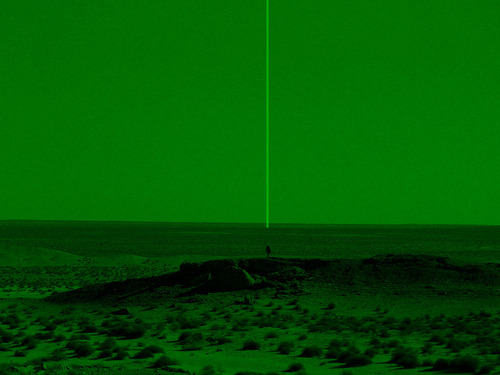
James Bridle, Light of God, 2012
Real time media as an accelerator of emotions
During the 2012 London Olympics millions of people shared their joy and excitement on online social networks such as Facebook, Weibo and Twitter. When recently two bombs exploded at the Boston Marathon finish line, those same people immediately went online to share their fear and horror of these gruesome attacks. These instant communication technologies and the worldwide dissemination of information play a major role in the creation and acceleration of emotions. The fear after an attack in Boston can now be simultaneously felt in England and Chechnya. The phenomena of ‘acceleration’ and ‘immediacy’, which were mapped out by philosophers such as Paul Virilio and Peter Sloterdijk during the Gulf War and 9/11, are up for reverification in these times of real time social media.
Dread warns us of dangerhttp://web.archive.org/web/20130824024727/http://thedreadexhibition.com/
Dread (literally: being anxious for) is the ominous feeling in our body that warns us for possible dangers. According to the Danish philosopher Søren Kierkegaard dread is not so much a fear of the here and now, but a fear of the future. Sigmund Freud suggests that dread makes us ready for danger.
Art offers perspectives
Dread explores how artists seize this ominous expectation of the future as a productive source for their work. In the conviction that artists are capable of offering new perspectives on the dangers of technology, the exhibition tries to gain an insight into the meaning of dread in contemporary visual art. On the one hand we can come to terms with our fears by facing them. On the other hand the experience of dread, as suggested by British science-fiction author China Miéville, can be interrelated with the sublime. For some artists connecting an aesthetical experience with fear can thus be a goal in itself. The exhibition traces this particular field of tension and highlights themes like surveillance, privacy and drone warfare.
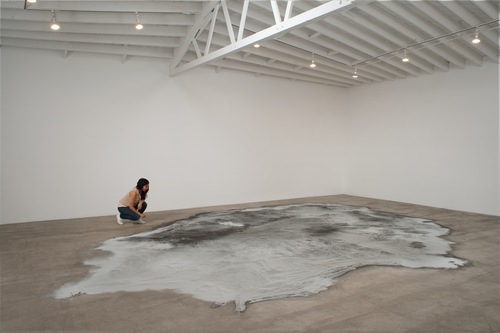
Roger Hiorns, Untitled, 2008
Every two years De Hallen Haarlem offers a young curator the chance to realise an exhibition project. With this initiative the museum for modern and contemporary art wants to stimulate the development of talent among young curators in The Netherlands and bring about a fruitful exchange with young thinkers and makers from outside the museum. The De Hallen Haarlem Young Curators’ Grant has been made possible by the generous support of the Dr. Marijnus Johannes van Toorn & Louise Scholten Foundation.
Events
06/09/2013 - 24/11/2013 Exhibition: Timo Arnall (UK), Micol Assaël (IT), Mark Bain (US), James Beckett (SA), James Bridle (UK), Constant (NL), Alicia Framis (ES), Laurent Grasso (FR), Carl Michael von Hausswolff (SE), Roger Hiorns (UK), Thomas Hirschhorn (CH) & Marcus Steinweg (DE), Gert Jan Kocken (NL), Jonas Lund (SE), Aditya Mandayam (IN), Metahaven (NL), Kianoosh Motallebi (IR), Trevor Paglen (US), Espen Sommer Eide (NO), Sarah van Sonsbeeck (NL), Berend Strik (NL)
Venue: De Hallen Haarlem
06/09/2013 Dread opening: Performances by Stephen O’Malley (US) and Espen Sommer Eide (NO)
Venue: De Hallen Haarlem
13/09/2013 Dread music festival: tba
Venue: Muziekgebouw aan ‘t IJ
14/09/2013 Dread music festival: Emtpyset (UK), Paul Jebanasam (LK), Roly Porter (UK)
Venue: tba
26/10/2013 Dread symposium: Johan Grimonprez, Gabriel Lester, tba
Venue: Eye
26/10/2013 Dread film event: tba
Venue: Eye